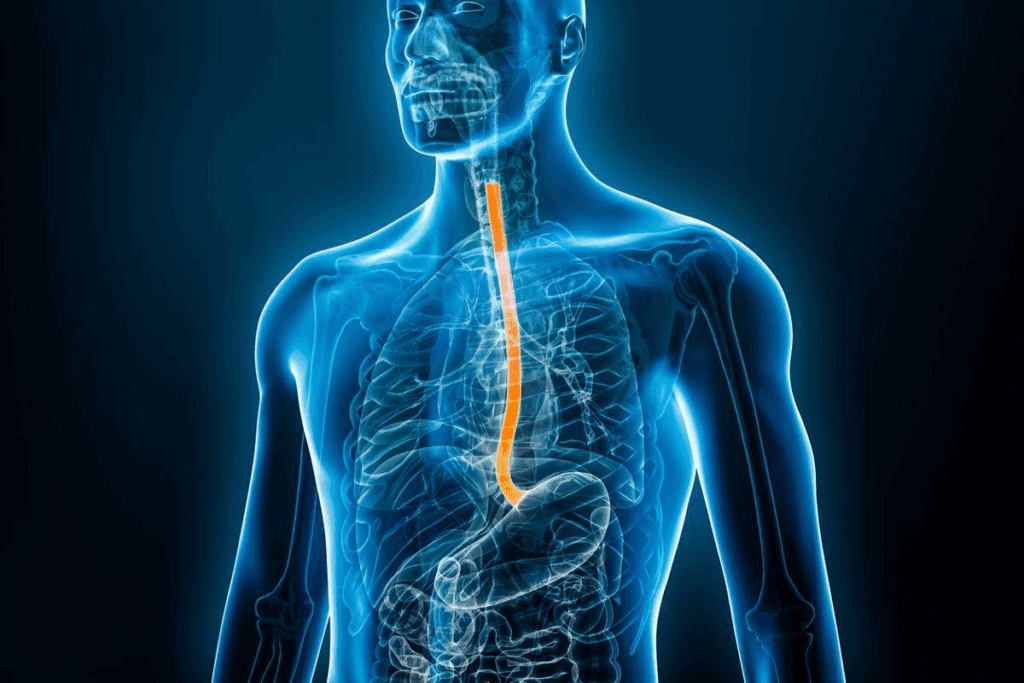
The coronary arteries are key blood vessels. They send oxygen-rich blood directly to the heart muscle. This is vital for the heart to work well and stay healthy.Learn what does coronary artery do and how it supplies blood to the heart.
The name “coronary” comes from how these arteries circle the heart, like a crown.
At Liv Hospital, we know how important coronary arteries are for heart health. The left main coronary artery and the right coronary artery start from the aorta. They are key in bringing oxygen and nutrients to the heart muscle.

The coronary arteries are key to the heart’s health. They carry oxygen and nutrients to the heart muscle. This keeps the heart pumping well.
Coronary arteries are blood vessels that feed the heart muscle. They include the left main coronary artery and the right coronary artery. These arteries and their branches make sure the heart gets the oxygen and nutrients it needs.
The heart is a muscular organ that needs blood to keep pumping. Even though it’s filled with blood, it needs its own blood supply. The coronary arteries provide this, keeping the heart muscle healthy and working right.
To grasp the importance of coronary arteries, we must look at the heart’s structure and function. The heart has four chambers: the right and left atria, and the right and left ventricles. The coronary arteries supply blood to these chambers, with the RCA mainly serving the right side of the heart.
| Coronary Artery | Region Supplied | Function |
| Left Main Coronary Artery (LM) | Left side of the heart | Supplies blood to the left ventricle and left atrium |
| Right Coronary Artery (RCA) | Right side of the heart | Supplies blood to the right ventricle and right atrium |
| Left Anterior Descending Artery | Anterior wall of the heart | Supplies blood to the anterior wall of the left ventricle |
In summary, the coronary arteries are essential for the heart’s function. They supply the heart muscle with oxygen and nutrients. Knowing their role is key to understanding heart health and function.

Knowing how the coronary arteries work is key to understanding the heart. These arteries wrap around the heart, feeding it with blood. This is essential for the heart’s health.
The coronary arteries start from the aorta, the biggest artery in our body. They come out of the aortic sinuses, small areas in the aortic wall. The left main coronary artery and the right coronary artery are the main branches.
The left main coronary artery splits into the left anterior descending (LAD) artery and the circumflex artery. The right coronary artery leads to the right marginal artery and the posterior descending artery in most people.
The major coronary arteries and their branches feed different parts of the heart. The left anterior descending artery runs down the front of the heart. It supplies the front wall and most of the interventricular septum.
The circumflex artery goes around the heart, feeding the sides and back. The right coronary artery and its branches, like the right marginal artery, supply the right atrium, right ventricle, and the heart’s back.
The coronary circulation is vital for the heart’s work. It makes sure the heart muscle gets the oxygen and nutrients it needs. This is how the heart pumps blood all over the body.
| Coronary Artery | Region Supplied | Major Branches |
| Left Main Coronary Artery | Left side of the heart | LAD, Circumflex |
| Right Coronary Artery | Right atrium, right ventricle, posterior heart | Right Marginal, Posterior Descending |
| Left Anterior Descending (LAD) | Anterior wall, anterior 2/3 of interventricular septum | Diagonal branches, septal perforators |
By learning about the coronary arterial system, we see how complex and detailed it is. It’s amazing how it supports the heart’s function.
The left main coronary artery is key for the heart’s health. It makes sure the heart muscle gets the oxygen and nutrients it needs. This artery starts from the left aortic sinus of the aorta and is vital for blood supply to a big part of the heart.
The LM heart artery is short, from a few millimeters to a couple of centimeters. It splits into two main branches. It starts from the aorta, the main artery that carries blood from the heart to the body. The left main coronary artery is between the pulmonary trunk and the left atrial appendage.
“The left main coronary artery is a critical structure that requires careful consideration in both medical practice and research,” as noted by cardiovascular experts. Its structure and location underscore its importance in cardiac health.
The left anterior descending (LAD) artery is a main branch of the left main coronary artery. It runs along the anterior interventricular groove towards the heart’s apex. It supplies blood to the heart’s anterior wall, the anterior two-thirds of the interventricular septum, and often the apex.
The LAD is called the “widowmaker” because blockages here are very dangerous. It’s essential for the left ventricle’s blood supply.
The circumflex artery is another major branch of the left main coronary artery. It runs in the left atrioventricular groove and supplies blood to the left ventricle’s lateral and posterior walls. The circumflex artery has several branches, like the obtuse marginal branches, which reach the lateral wall of the left ventricle.
The circumflex artery’s role varies among people, but it’s vital for the left ventricle’s blood supply.
The right coronary artery is key for the heart’s backside. It brings blood to these areas. It starts from the aorta, just above the aortic valve.
The artery runs between the pulmonary trunk and right atrium. It’s in the right atrioventricular groove. Then, it curves around the heart’s acute margin, moving to the back.
It branches out to supply different heart parts. Knowing its path helps us see how it supports the heart’s back.
The right coronary artery has a big branch called the posterior descending artery (PDA). The PDA goes through the posterior interventricular groove. It supplies the heart’s posterior third, including the interventricular septum.
The PDA is key for the heart’s backside. It makes sure the ventricles and septum get enough blood.
The right coronary artery and its branches, like the PDA, feed the right ventricle and the left ventricle’s back. They also supply the interventricular septum’s back third.
This ensures the heart’s back gets enough oxygen and nutrients.
| Region Supplied | Artery Responsible |
| Right Ventricle | Right Coronary Artery |
| Posterior Aspect of Left Ventricle | Right Coronary Artery and Posterior Descending Artery |
| Posterior Third of Interventricular Septum | Posterior Descending Artery |
It’s key to know how coronary arteries supply blood to the heart. They carry oxygen and nutrients to the heart muscle. This is vital for the heart to work right.
The coronary arteries send oxygen and nutrients to the heart muscle in a detailed process. About 5% of the heart’s blood goes to the muscle through these arteries. This makes sure the heart muscle gets what it needs to work well.
The sinoatrial nodal branch, a part of the coronary arteries, brings blood to the sinoatrial node. This shows how complex the blood supply to the heart’s important parts is.
Coronary blood flow is controlled in many ways to make sure the heart gets enough oxygen and nutrients. This control is key for the heart to work well, even when it’s under stress.
The flow of blood in the coronary arteries changes based on how much oxygen the heart needs. This change is due to many factors, like what the heart makes and how the blood vessels react.
The heart’s activity level and blood flow are closely linked. When the heart works harder, it needs more oxygen and nutrients. This makes the coronary blood flow increase to meet that need.
| Heart Activity Level | Coronary Blood Flow | Oxygen Demand |
| Low | Decreased | Low |
| Moderate | Moderate | Moderate |
| High | Increased | High |
This connection between heart activity and blood flow shows why a healthy coronary system is so important. It helps the heart function well.
The coronary arteries have special branches that are key for the heart’s health. These branches make sure every part of the heart muscle gets the oxygen and nutrients it needs. We’ll look at the obtuse marginal (OM) artery, diagonal branches, and septal perforators. They are all important parts of the coronary system.
The obtuse marginal (OM) artery comes from the circumflex artery. It runs along the left side of the heart, giving blood to the left ventricle’s lateral wall. The OM artery is very important for the heart’s function because it supplies a big part of the heart muscle.
The importance of the OM artery is huge. It’s often affected by heart disease. Knowing how it works and its weaknesses is key for diagnosing and treating heart problems.
The coronary system also has diagonal branches and septal perforators. Diagonal branches come from the left anterior descending (LAD) artery. They supply the front part of the left ventricle. These branches are vital for the heart muscle’s blood supply.
Septal perforators also start from the LAD. They go through the interventricular septum, giving blood to this important area. The septal perforators help keep the septum strong, which is essential for the heart’s pumping action.
The OM artery, diagonal branches, and septal perforators work together. They make sure the heart gets the blood it needs. Understanding these branches is key to knowing how coronary circulation works and why keeping coronary arteries healthy is so important.
Understanding the regional blood supply is key to grasping heart anatomy and function. The heart is complex, with different areas needing specific blood supplies to work right.
The coronary arteries are in charge of bringing blood to the heart muscle. They make sure every part of the heart gets the oxygen and nutrients it needs.
The ventricles, the heart’s main pumping chambers, need a lot of blood. The right coronary artery (RCA) mainly feeds the right ventricle. The left coronary artery (LCA) looks after the left ventricle.
| Ventricle | Primary Artery Supply |
| Right Ventricle | Right Coronary Artery (RCA) |
| Left Ventricle | Left Coronary Artery (LCA) |
The atria, the heart’s upper chambers, get their blood from the coronary arteries. The RCA usually feeds the right atrium. The LCA looks after the left atrium.
This blood supply is important for the atria’s work. This includes the sinoatrial (SA) node, the heart’s natural pacemaker.
Mapping the heart’s areas and their blood supply is key. It shows the complex network of coronary circulation. The coronary arteries split into smaller vessels that reach different heart parts.
Knowing these details is critical for diagnosing and treating heart diseases.
The health of our coronary arteries is key to our heart’s function. They supply blood to the heart muscle. Keeping them healthy is vital for avoiding heart disease.
Coronary artery disease is a major cause of death globally. It happens when the arteries narrow or block. This is often due to atherosclerosis, a buildup of plaque.
Blocked arteries can cause tissue damage or heart attacks. It’s important to know the risks and how to prevent them.
Other issues include coronary artery spasm and aneurysm. These can also harm heart health.
Bad coronary circulation can lead to serious problems. These include angina, heart failure, and arrhythmias. Not enough oxygen and nutrients can damage the heart muscle.
Coronary artery disease can greatly affect the heart’s function. It can make it hard for the heart to pump blood well. This can cause many complications, from mild to severe.
Keeping coronary arteries healthy is essential for heart health. This can be done through lifestyle changes and medical care. A healthy diet, regular exercise, and not smoking are key to preventing coronary artery disease.
Managing high blood pressure, diabetes, and high cholesterol also helps. Regular health check-ups can catch problems early.
By understanding the importance of coronary artery health and taking action, we can lower heart disease risk. This helps keep our cardiovascular system healthy.
The coronary arteries are key to heart health. They bring oxygen and nutrients to the heart muscle. We’ve learned how these vessels support the heart’s function.
Good coronary circulation is vital for heart health. These arteries give the heart the blood it needs to work right. Keeping them healthy is key to avoiding heart disease.
Knowing how important coronary arteries are helps us see why a healthy lifestyle matters. It also shows why regular heart checks are important. This knowledge helps us take care of our hearts and stay healthy.
The coronary arteries carry oxygen-rich blood to the heart. This lets the heart work right and keep pumping.
The left main coronary artery and the right coronary artery start from the aorta. They are key to the heart’s function.
The left main coronary artery splits into the left anterior descending artery and the circumflex artery. These supply a big part of the heart with oxygen and nutrients.
The right coronary artery feeds the heart’s back parts. It also gives rise to the posterior descending artery. This artery is vital for the heart’s back side.
Coronary arteries control blood flow through complex ways. They adjust to the heart’s activity. This ensures the heart muscle gets enough oxygen and nutrients.
The obtuse marginal artery is a branch of the circumflex artery. It’s very important for the lateral wall of the heart, supplying it with oxygen and nutrients.
Different heart areas get their blood from various branches of the coronary arteries. This includes ventricle arteries, atrial branches, and more.
Bad coronary circulation can cause serious problems. This includes coronary artery disease, heart failure, and even life-threatening conditions.
Keeping coronary arteries healthy involves lifestyle changes. This includes eating right, exercising, and managing stress. It also means taking care of any health issues.
Coronary circulation is very important for heart health. Knowing how it works helps us see why coronary arteries are key to our heart’s well-being.
Subscribe to our e-newsletter to stay informed about the latest innovations in the world of health and exclusive offers!
WhatsApp us